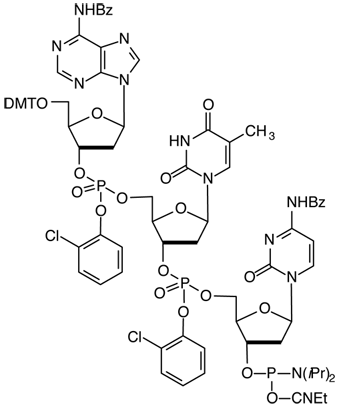Glen Report 20.112: Technical Brief - Phage Display, Artificial Antibodies and Trimer Phosphoramidites
With the incredible affinity and specificity that they afford, antibodies have become an indispensable tool for biological research, in vitro diagnostics, and proteomics.
Traditionally, hybridoma technology1 has been used to produce these antibodies – a labor-intensive and time-consuming process that typically involves the immortalization of murine B cells in mice that have been inoculated with an antigen. However, there is a powerful alternative technique that is growing in popularity - phage display.2 In phage display, a bacteriophage - typically T7 or M13 - is engineered to express antigen-binding fragments (Fabs) on the protein coat of the viral particle. These viral particles can act essentially as artificial antibodies with Kd values often below 1 nM. However, unlike standard antibodies, these viral particles contain the DNA sequence defining the binding motif, allowing for easy sequence analysis and manipulation. Typically, a large phage library is enriched in clones that bind the antigen of interest by affinity sorting - going through multiple rounds of selection and amplification under increasingly stringent conditions. Happily, these procedures are easily amenable to high-throughput approaches with phage display systems.
Fundamental to the success of phage display, however, is generating high diversity in the library itself for which Trimer Phosphoramidites are ideally suited. Using high-throughput techniques, Fellouse and colleagues3 were able to generate a phage display library with a theoretical diversity of 1030 clones. When tested against a panel of 14 diverse proteins with low sequence homology, they were able to find high affinity phage expressing Fabs against all of the target proteins tested. Remarkably 83% of the clones exhibited Kd values lower than 20 nM and 10% lower than 1 nM.3 In a second paper, the more traditional NNK-generated phage library was compared to those generated by Trimer Phosphoramidites. The Trimer Phosphoramidite-generated library was found to be an order of magnitude more diverse and had increased amino acid uniformity,4 clearly illustrating the utility of the Trimer Phosphoramidite technology.

References
- G. Kohler, and C. Milstein, Nature, 1975, 256, 495-7.
- H.R. Hoogenboom, et al., Immunotechnology, 1998, 4, 1-20.
- F.A. Fellouse, et al., J Mol Biol, 2007, 373, 924-40.
- L.R. Krumpe, K.M. Schumacher, J.B. McMahon, L. Makowski, and T. Mori, BMC Biotechnol, 2007, 7, 65.
Product Information
- Glen Report 20.11: An Unnatural Base Pair System for the Expansion of Genetic Information
- Glen Report 20.12: Thiophosphoramidites and Their Use in Synthesizing Oligonucleotide Phosphorodithioate Linkages
- Glen Report 20.13: Technical Brief - Purification of 6-FAM Labelled oligos using Glen-Pak™ Cartridges
- Glen Report 20.14: More Click Chemistry
- Glen Report 20.15: Technical Brief - New application of 5-Me-iso-dC and iso-dG
- Glen Report 20.16: Technical Brief - New application for 5’-OMe-dT phosphoramidite
- Glen Report 20.17: New Product - Deuterated 2’-Deoxyguanosine Phosphoramidite
- Glen Report 20.18: New Products - Solid CPR II / Formylindole – Aldehyde Modifier
- Glen Report 20.19:New Product - 5'-Cholesteryl-TEG Phosphoramidite
- Glen Report 20.110: Improving Universal Support II for Oligonucleotide Synthesis
- Glen Report 20.111: Differences Between Universal Support II and III
- Glen Report 20.112: Technical Brief - Phage Display, Artificial Antibodies and Trimer Phosphoramidites

